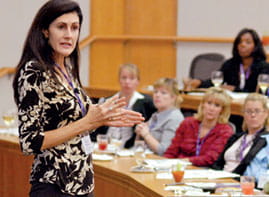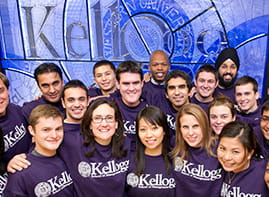Second day at Kellogg School Marketing Conference brimming with unconventional wisdom
1/30/2008 - Marketing targets more narrowly defined consumer segments all the time, but whether this translates into a more sophisticated approach depends.
| |
 |
Related Video |
| |
Pam Kaufman |
|
|
|
This video is password protected for the Kellogg Community | | |
| |
|
| For example, the top-rated cable television channel in the U.S., Nickelodeon, creator of “SpongeBob SquarePants,” likes to compare its programming to, ahem, noisy flatulence suddenly emerging in a quiet concert hall, according to Pamela Kaufman, Nickelodeon’s chief marketing officer. She delivered a keynote address at the 2008
Kellogg Marketing Conference, held at the Donald P. Jacobs Center on Jan. 26.
“We are built on a kid-centered philosophy,” Kaufman told those gathered for the second of the two-day event. “We always have a kid point of view.”
Witness the channel’s annual Kids Choice Awards, in which youthful viewers have a voice on all the awards, including categories like Celebrity Burp Champion. “It’s very important — to our audience — who does the best,” Kaufman said, noting that more than 1 million votes were cast online last year to determine which celebrities should get “slimed,” and how. “It’s an unbelievable event, from a marketing perspective.”
The channel has expanded from its cable TV roots to a “multi-splatform” architecture that includes a magazine, Web site, retail that generated $5.2 billion in 2007, 20 resorts opened in partnership with Marriott, and a soon-to-be-launched theme park at the Mall of America in the Twin Cities area, said Kaufman, one of three keynotes speaking as part of the student-run conference’s second day.
But Nickelodeon keeps a central focus on television, she said, with “SpongeBob” on the air in 175 countries, “Dora” a breakthrough show for a Latina character that’s led to a spin-off, “Go Diego Go,” and the newer “iCarly,” which invites viewers to submit their own iMovies to be played on the air, “a true phenomenon for us, as well.”
Burps and slime are the farthest thing from the mind of Mark Mitten ’83, senior vice president for marketing and legacy at Chicago 2016, the organization formed to bring the 2016 Olympics to Chicago. His key target audience is the 115 members of the International Olympic Committee, which ranges from royalty to ex-athletes.
“Our challenge is a one-time-only sale, but it’s the biggest sale of a lifetime” said Mitten, who participated in a panel on customer relationship management. “It’s absolutely the most difficult audience to read in the world.”
Chicago 2016 has 21 months to build its brand before the IOC makes a decision, all on a $49.5 million total budget, and “the marketing budget … is not a great part of that budget,” Mitten said. “The nice thing about Chicago is, it’s an undiscovered gem.”
Customer relationship management became a focus of The Gap, Inc. about a decade ago, said panelist Suzy Cirulis, director of CRM. Prior to then, stores kept records and called local customers; by 2006, the clothing retailer, which encompasses Old Navy and Banana Republic in addition to its flagship, had launched cross-branded programs among the three stores and a co-branded credit card with VISA, she said.
The chain imagines its target customer as a married, career woman named “Cindy,” who signs up for the credit card while buying work clothes at Banana Republic, Cirulis said. She returns to the Gap Maternity Stores when she finds out she’s pregnant, then purchases baby clothes at Old Navy. “Our loyalty program is really rooted in our card program,” Cirilus said.
Target attempts to target its best customers through traditional direct marketing, e-mail and receipt marketing, but that only works for 10 percent to 20 percent of guests, said Kate Whittington, group manager for guest insights and another panelist. Although those guests drive 40 percent or more of revenue, Target does not want to focus on them too much because the retailer believes occasional customers might become more frequent if treated well.
“We don’t look at the value of the guest,” Whittington said. “We make sure every guest is treated with respect.” As consumer segmentation technology advanced, Target made mistakes early on by targeting too narrowly, but the chain has since realized that “it’s not just about one particular guest; it’s about all your customers.”
Target does make specific changes based on segmentation research; for example, the chain moved toward co-locating all of its baby-related products in one place and targets direct mail, e-mails and other means of communication to a 31-year-old mother with a new baby, “very specific to her, and her patterns” of shopping, Whittington said.
During the next decade, marketers will need to pay attention to five trends in particular, said
Julie Hennessy, a Kellogg clinical marketing professor who delivered another keynote address at the conference. Consumers are increasingly defined by their differences, media have become splintered along with the consumer base, retailers have grown in power and influence vis-à-vis suppliers, domestic versus international is no longer a meaningful distinction, and corporations will be expected to be socially responsible.
“Technology has the ability to micro-target,” Hennessy said. “We’re just beginning to understand what this allows us to do. … It’s fuzzy, it’s uncertain, and the resolution on our image is bad.”






